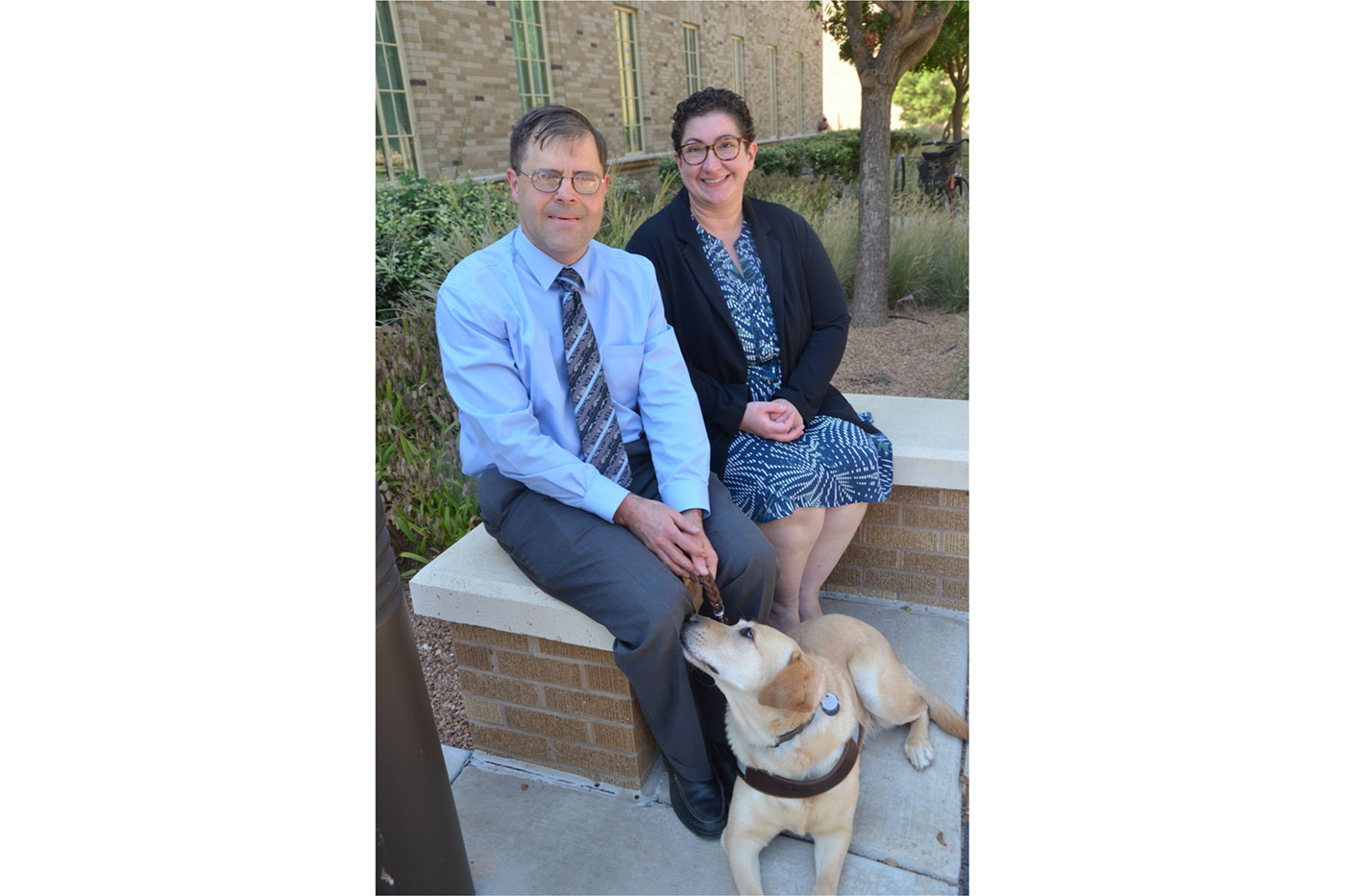Two Psychological Sciences professors are leading a team that received a $3.6 million grant from the National Institutes of Health.
One long-neglected area of research is examining the lives of children dealing with blindness or other visual impairments. Although some medical research has focused on childhood eye conditions themselves, there is even less work around the experiences those children have in families, schools, peers and other settings as a result.
Sarah Victor and Adam T. Schmidt plan to change that narrative. The two associate professors in the Clinical Psychology Program within the Department of Psychological Sciences in the College of Arts & Sciences at Texas Tech University are leading a team that recently earned a $3.6 million grant from the National Eye Institute, under the auspices of the National Institutes of Health (NIH).

If it sounds like a big deal, that’s only because it is. The five-year award is the largest NIH grant funded in the department’s history.
“It says something about the groundwork that has been done here at Texas Tech that supports this type of grant,” Victor said. “The resources we’ve had as faculty, support for research, and support for grant writing at both the department and university level, has been incredible.
“There are a lot of things here that have set us up to be able to go to the NIH and say, ‘We haven’t done this kind of work before, but we know what we’re doing and we’re at an institution where we have the resources and support to do it.”
According to the Centers for Disease Control, approximately 3% of children in the U.S. are blind or visually impaired. However, most of the research done in this area involves older adults, a segment of the population that experiences eye issues such as glaucoma or cataracts more frequently than children.
Beyond that, virtually no work has been done on the health inequities or other negative impacts children face as a result of their condition, defined as “ableism” in scholarly literature. In other words, they are often excluded from access to cultural, educational, occupational and recreational opportunities because of their visual impairment.
“In this case, ableism is related to things like discrimination, victimization, rejection or isolation,” Victor said. “Low expectations as far as what they kids think they can achieve. Our goal is to look at the effects those experiences have on kids who are blind or visually impaired.”
Also included on the research team is Jason Van Allen, associate professor in Psychological Sciences. His research expertise includes sleep and physical activity for children.
Another member of the team is Rona Pogrund, professor in the College of Education. She is leading efforts to recruit research participants and ensure the study is accessible to children with a range of visual impairments and other disabilities.
“One of her big jobs is going to be helping us make connections, not just in Texas but across the country,” Schmidt said. “A lot of her role will involve access.”
Children who are blind or visually impaired experience high rates of physical and mental health disorders. The research will focus on identifying the role of ableism in driving physical and mental health inequities, resulting in poor health outcomes for vulnerable children.
Others on the team are Leslie Brick at Brown University, Katie Wang at Yale University and Gordon Legge at the University of Minnesota. The research will also eventually include several full-time paid staff and several graduate student researchers.
Early work includes bringing together an advisory board of subject-matter experts, both adults who were visually impaired as children and parents of children who are visually impaired, who can provide counsel and insights to the researchers along the way. Schmidt and Victor want a group from across the country who have had different experiences to help inform the research as it progresses.
Likewise, the plan is to pull together a group of 500 children from across the country with various backgrounds and experiences.
“This will be such a heterogeneous group of kids that has really never been looked at before,” said Schmidt. “I think that is one of the really, really exciting things, having a large and diverse group whose biggest issue is vision, although there will be some with multiple disabilities.”
Once the group begins to take shape, the researchers will assess the participants’ mental and physical health. Participants will be interviewed and fill out surveys. Additionally, the research will include cognitive and achievement testing. They will even measure participants’ physical activity and sleep.
“One thing we noticed is there are very few existing tools to measure these experiences,” Victor said. “And the ones that do exist are designed for people with all kinds of disabilities. They are not necessarily just for kids, and they’re not necessarily just for folks with visual impairment, so they don’t always capture the right things.”
The work has special meaning for both Schmidt and Victor. Schmidt grew up with pediatric glaucoma, so studying visual impairment has long held interest for him. It became even more personal once he learned his son had inherited the disorder.
“Pediatric glaucoma is very different from glaucoma,” he said. “It is also a much more complicated condition. It is a fundamentally different disorder that happens to be called the same thing. My research is with kids and showing their diversity and resiliency, and I do a lot of work with kids involved in the justice system.
“Then my son inherited my eye condition, which we knew was possible. So, seeing him in his element as far as education and watching his journey unfold, as well as his life intersecting with the medical system, brought everything to another level as a parent.”
Although Schmidt said his son’s experiences in school have been overwhelmingly positive, they were still influential in terms of pursuing this research.
Victor, meanwhile, has what she described as invisible disabilities, which prompted her to get involved in disability scholarship. There was a family influence as well, as her father had both visual and mobility impairments. She has been vulnerable with others in terms of sharing her lived experiences, which has helped her make connections as both a researcher and faculty member.
“Between all of that, I’ve had a lot of graduate students and undergrads come up and tell me how they appreciate me being open about my life and doing this work,” she said.
Their perspectives nicely complement each other academically as Schmidt and Victor combine their personal backgrounds with their research disciplines. Schmidt’s specialties include child development, neuropsychology and early life adversity. Victor’s expertise is in stigma, minority stress and self-injurious behaviors. Those connections are partly what led to their decision to pursue the NIH grant.
“Considering Adam’s experiences and our interests together, we saw this call for applications and thought there had to be people out there already doing this work,” Victor said. “We would be new to the area while there were already people doing it, and then we realized there was basically nobody doing it.”
That dearth of scholarly work provoked a range of emotions, beginning with frustration and eventually morphing into excitement as Schmidt and Victor realized they had an opportunity to be trailblazers for a cohort of children that numbers approximately 500,000.
The grant also represents something of a paradigm shift for the National Eye Institute. Historically, its awards were focused toward research that would prevent, treat or cure blindness and visual impairments. However, research into the experiences of people living with blindness and visual impairment were not among the organization’s top funding priorities. And, across the entire NIH, funding for this population is low.
Current figures show NIH spending per child breaks down to almost $20,000 for each child with leukemia and roughly $180 for each child with cystic fibrosis, yet only $3.21 is spent for each child with blindness or visual impairment.
“We think it’s pretty cool that the decision makers at the National Eye Institute decided this was a project worthy of funding,” Victor said.
Still, it’s heady stuff, having a chance to plow into fertile, new research terrain.
“I told someone, ‘This is exciting and terrifying,’” Victor said. “But everything worth doing in life is a combination of those things. So, that’s a nice way to look at it.”
And it’s more than that.
“For me,” Schmidt said, “and this is probably more personal than professional, I would like to communicate things to the medical community and the wide variety of practitioners about understanding: Even if you can’t cure something, you can still live with it and thrive.”

